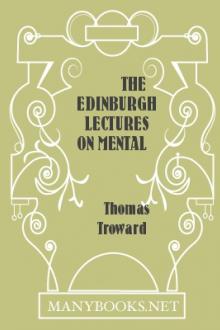London Lectures of 1907 by Annie Besant (little readers TXT) 📕

Read free book «London Lectures of 1907 by Annie Besant (little readers TXT) 📕» - read online or download for free at americanlibrarybooks.com
- Author: Annie Besant
Read book online «London Lectures of 1907 by Annie Besant (little readers TXT) 📕». Author - Annie Besant
[Footnote 1: This was spoken some weeks before the issue of Mr. Sinnett's extraordinary manifesto, denying "the things most surely believed among us."]
The Future of the Theosophical Society
There are two futures of the Theosophical Society to which we may address our attention: the immediate future, and a future further off. And I am going to begin with the future further off, because it is only by recognising the nature of that future that we can properly devise the means whereby we may bring it about. For in all human affairs it is necessary to choose an end to which effort should be directed, and the nature of the end will govern the nature of the means. One of the great faults, I think, of our modern life is to live in what is called a hand-to-mouth way, to snatch at any momentary advantage, to try to bring about something which serves as an improvement for the moment without trying to understand, without caring to consider, whether in very many cases the temporary improvement may not bring with it a more fatal mischief than that which it is intended to remedy. And at least in the Theosophical Society, where we try to study tendencies, and to understand something of the forces which are working around us in life, we ought to avoid this popular blunder of the time, we ought to try to see the goal towards which we are moving, and to choose our immediate methods with reference to that goal. Of course, when I speak of a goal and an end, I am using the terms in a relative, not in an absolute sense--the goal, the end which is within a measurable distance, and so may be taken as a point towards which the roads on which we travel should tend. Let us, then, look first on that goal, and see its nature and the kind of methods which will help to realise it upon earth.
You are all familiar in the Theosophical Society with the theory of cycles, so that you are accustomed to look upon events as tending to repeat themselves on higher and higher levels of what has been called the "spiral of evolution." For while it is true that history does not repeat itself upon the same level, it is also true that it does repeat itself upon successively higher levels, and that anyone who is studying Theosophical teaching as to the evolution of man, the evolution of globes, the evolution of systems, the evolution of universes, may very much facilitate his study by grasping the main truths which underlie each of these in turn. We are continually repeating on a higher plane that which we have done upon a lower. Our terms are a constant series of repetitions, so that if we understand their meaning in one series we are able to argue to their meaning in another. And I have often pointed out to you with respect to these recurring cycles of events, and recurring terms, that especially among Hinḍus, and in the Samskṛiṭ language, you find whole series of terms, the meaning of each of which varies with the term from which the series starts; so that if you know them once, you know them for all occasions. Take a very familiar case. Let me remind you of the word "samâḍhi." That is a relative term, and is the last of a series, which has regard to the waking consciousness of the individual and the plane on which the centre of the waking consciousness is found. So that before you can say what the word "samâḍhi" means for any individual, you must ascertain on what plane of consciousness his normal centre is at work; and when you know that, then you can pass up step by step until you come to the term in the series which is represented by that word "samâḍhi." It is the same over and over again in our Theosophical studies, and especially do we find this to be true in the characteristics--important in this particular relation--the characteristics of the great Races, the Root-Races, as represented in miniature in the sub-races of each Root-Race. If we can find out those characteristics, trace them and see how they are brought about in the course of evolution in the small cycle which is nearer to us, the cycle of the sub-race, then it is comparatively easy for us, as regards the future, to foresee the appearance of those characteristics in the Root-Race that corresponds to the sub-race. And I shall want to use that method in dealing with the future of the Society; it is for that reason that I draw your attention to these continually recurring cycles of times and events. Now if we look back to the Fourth Root-Race, we can study in the history of that Race the evolution of the Fifth. We can see the methods used to bring about that evolution. We can trace the means which were employed in order that that evolution might be made secure; and we can see, by studying that which lies behind us, that the fourth sub-race of that Root-Race showed out the characteristics of the Fourth Race as a whole; that the fifth sub-race of that Fourth showed out some of the characteristics of the Fifth Root-Race that was to follow in the course of evolution. And in this way, applying the analogy, if we can trace out to some extent for ourselves the characteristics of the sixth sub-race which is to succeed our own fifth sub-race, then we shall be on the track of the line of evolution which will bring about the Sixth Root-Race when the time for its coming strikes. Let us glance back for a moment to see the main points of the evolution of a sub-race and a Race.
When our own Fifth Root-Race was to be evolved, certain types were chosen out of the fifth sub-race of the Fourth Root-Race, and they were chosen by the Manu who was to guide the evolution of the Fifth Root-Race. Those types showed out in a comparatively germinal fashion the mental characteristics which were to grow out of the selected groups. And you may learn, if you care to do it, how those choices were made, and how the first choice was a failure. Chosen as it was by the wisdom of the highly exalted being whom we speak of as the Manu, none the less the material in which He tried to work proved too stubborn, too little plastic, to adapt itself to His influence striving to shape and to mould it. And in consequence, after prolonged efforts, He threw aside the families that thus He had selected, and began making a new choice, a fresh selection, in order to see if the second choice would prove more fortunate than the first. And the way He chose them was a simple and effective one: He selected a certain number of His own disciples and sent them out as messengers to the various nations of the world, that constituted that part of the great Fourth Race which He had chosen for His second experiment. He sent them into nation after nation, with the mission to gather out of that nation those who appeared to be the most promising for the work which He had to carry out. They tried in various fashions, sometimes by direct invitation, where the characteristic that was being sought was clearly developed, namely, the lower mind. It was the development of the lower manas that was the keynote of the selection; for the Fifth Root-Race was to show out that development of the lower manas. I say "lower manas" rather than "manas"; because the full development of the mânasic principle in man is reserved for the Fifth Round, and not for the Fourth, and we, of course, are still in the Fourth Round. That Fourth Round, pre-eminently kâmic, must necessarily color every evolution which goes on during its existence, and high as we may strive to raise mânasic powers amongst us, we cannot escape from the fundamental vice of our birth, from the mânasic standpoint, that we are plunged in kâmic matter, and that the matter in which we work is matter of the Fourth Round, adapted to the kâmic principle, and not matter of the Fifth, adapted to the mânasic. Hence the best thing that we can do is to evolve the lower manas, manas deeply tinged with kâma. Out of that Fourth Race, then, were selected the people who showed most plainly the budding of this intelligence which was needed, the messengers of the Manu striking a note which attracted those in whom this lower mânasic principle was more highly developed than among their comrades and peers. Gradually from different nations groups of men and women gathered round the messengers of the Manu, who then began to lead them away from their own people, from their own nation, from all their surroundings, in order to seek the appointed place where the Manu was grouping those on whom the great experiment was to be made for the second time. Slowly and gradually they were thus gathered together out of the nations into which the fifth sub-race of the Fourth Race had spread. And the flower of those nations, attracted by the key-note struck by the messengers, gradually gathered round the Manu, and became the material, the nucleus, of the new Root Race. As you know, He took them far away to the Sacred Land, shutting them away from the masses of the Fourth and Third Race peoples, and dividing them by physical barriers from all that might contaminate and stain. Very, very different were those people from the generations which thousands upon thousands of years later were to spring from them in physical succession; rather, to the people about them were they folk who were developed in an uncongenial fashion, people who were by no means looked up to and admired in





Comments (0)